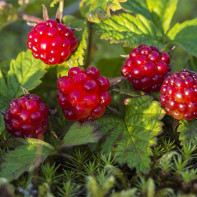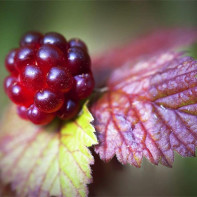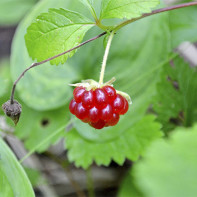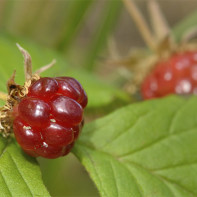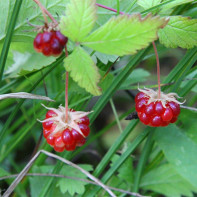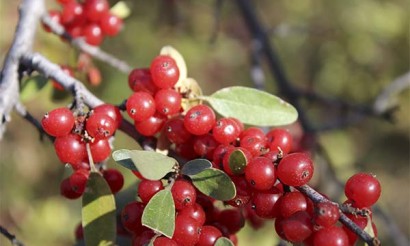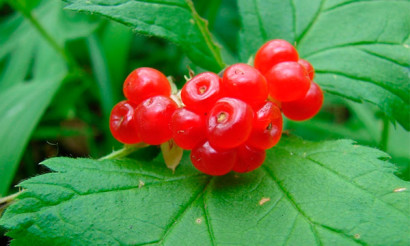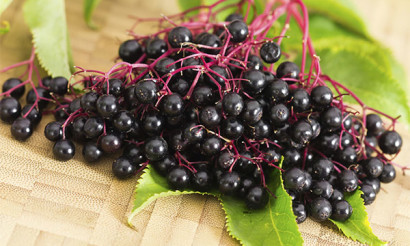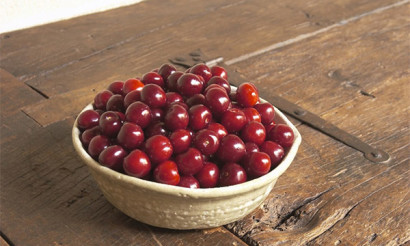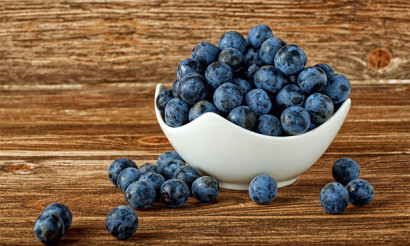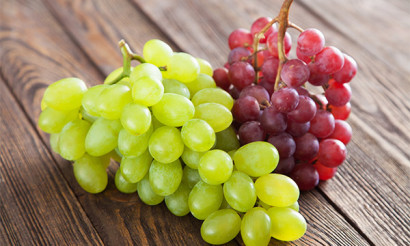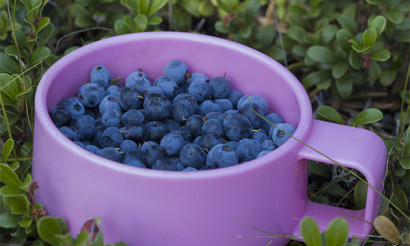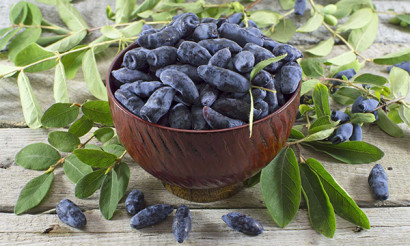Duchessberries: useful properties and contraindications
Duchessberries are called low herbaceous shrubs without thorns. These plants - perennial shrubs, which are frost-resistant, are ranked in the family of the Rose family. They grow and bear fruit for several years, that is, they are perennials.
- What is a prunus and what does it look like
- What is the difference between prunus and knuckleberry
- Features of growing
- Composition and calories
- Useful properties of Duchess
- General benefits
- For Women
- For Men
- In Pregnancy
- Breastfeeding
- For children
- For weight loss
- Anemia and vitamin deficiency
- Cosmetic applications
- Refreshing vitamin mask
- Tonic
- Harm and Contraindications
- How to cook Prunus berry jam
- How to choose and store
- Interesting Facts
What is a prunusberry and what does it look like
Also the culture is called ordinary knyazhenika, kumanika, Arctic raspberry, prince or royal berry, hohlushka, mamura, poludenitsa and polenika northern. Many raspberry hybrids are related to the shrub. A Brockhaus and Efron encyclopedic treatise states that the name "duchess" was applied to red currant shrubs in the late 19th century.
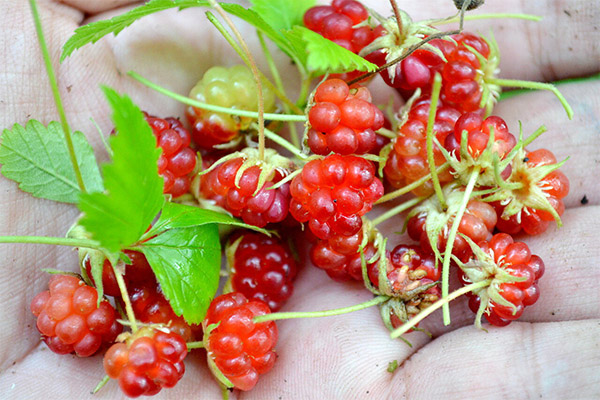
The berry grows in the northern latitudes of Russia. Moisture-saturated, shady places are preferred for the plant. Arctic raspberry bushes are often found near fresh water bodies, in herb-rich meadows, tundra forests, or swampy soils. The plant is common in the Sakhalin, Far East, Kamchatka and Ural regions. If desired, it can also be grown in the Russian midlands.
To taste the fresh royal berry, you will have to wait until late summer or early fall. Leaves are hoarded from mid-July. Harvested berries are great for jam or jam, freezing and drying. The therapeutic properties of Arctic raspberries were known to the inhabitants of ancient Russia. Healers used fruits and leaves and achieved positive results.
What is the difference between the knuckleberry and the raspberry
Each of the forest berries is extremely useful and often found in nature. However, only true fans of "silent hunting" can find them. Outwardly, both bushes and fruits are quite similar.
The bramble is often confused with polenika, and the botanical illiteracy of the population contributes to it. If the former has not yet received an alternative name, the latter has plenty of them. Another name, knuckleberry, causes bewilderment. There are doubts at once: isn't it the familiar brambleberry, maybe it's just a few letters mixed up? Botanically speaking, these cultures are totally different, but they still have something in common.
Why is bramble mistakenly called both plants? Each of the shrubs has a fruit with a small bone inside. In addition, they are united:
- belonging to the same Rosaceae family;
- the same shape of leaves;
- a small height of 30 to 50 cm;
- Their high requirements for moisture in the soil;
- flowering in the second half of May to early June;
- ripening of berries by the end of summer;
- prevailing red pigment in the fruit color;
- medicinal properties for humans.
One can understand the main differences between the compared crops by taking a closer look at the knuckleberry itself. On its bushes grow upright stripped shoots and creeping stems 150 to 300 cm long. The latter root and give birth to new plants. Mamura, on the other hand, aspires to height and does not form offshoots.
Bramble grows in damp meadow soils and in deciduous, coniferous and mixed forests in the Far East, Siberia and the Urals.
To fully enjoy the taste and benefits of both bramble and polenika, you need to know the simple rules of gathering these berries:
- Only manual picking is acceptable, because with mechanical devices the fruit is damaged, which reduces the shelf life.
- With the rising moon, the aroma of crops becomes richer.
- It is not recommended to leave the harvest under direct sunlight, because under the influence of ultraviolet light it will quickly lose its usefulness and rich flavor.
Bramble is also distinguished by its shield-shaped white inflorescences and sour-sweet berries with a pronounced pomegranate flavor, which include 3-4 small individual balls looking upward. And kohlrabi has sweeter fruits and smells like pineapple, hanging on long peduncles and not detached from the pips.
Bramble fruit has almost twice as much nutritional value as pine nuts and accounts for 40 kcal. Fruits contain 7.4 g of carbohydrates, 0.8 g of proteins, 0.9 g of fat, vitamins C, E, P, trace elements and minerals.
Both northern berries are especially valuable for the human body not only because of their vitamin composition, but also because of their medicinal properties, which are significantly different, which means that the fruits can have opposite effects.
For example, brambleberry promotes an increase in blood pressure, and polenika - a decrease. The berries and leaves of the first can also have diaphoretic, analgesic, anti-inflammatory and diuretic effects, eliminate the signs of colds and help get rid of the hated extra pounds.
Cultivation peculiarities
Planted as well as raspberry bushes, on plots with prepared soil - to obtain the harvest, it is enriched with humus, sand, organic fertilizers, wood ash and natural peat. The site should be both illuminated and slightly shaded by nearby growing trees or shrubs. In a warm cool place ripening will take place more evenly. At high temperatures, berries often dry out. It is recommended to plant different varieties on the same bed to intensify cross-pollination.
Land before planting should be treated with special agents to disinfect against fungal and mold spores and other harmful bacteria. The soil should also be loosened every three days. With timely moistening and proper care, prune plants produce up to 1.2-1.5 kg of fruit per square meter. This amount is enough to provide a family of 4 people with useful micronutrients during the winter.
The root system of the princely berry is creeping and located at a depth of 15-20 cm, sprawling on different sides. The stems are an averaged variation of raspberry and strawberry. The stubs have a spine of singularity. The shoots are fairly herbaceous with shaggy green ovaries. Since the home of the vole is considered the north, its bushes will not grow taller than 25-30 cm, even when cultivated in the latitudes of the middle belt. Enterprising breeders have bred certain varieties, reaching a height of 100-150 cm, which are suitable for planting in the latitudes of the middle strip.
The structure and appearance of the leaf plates of Crested Crested resembles crimson. They have a triple-droplet shape, pointed to the tip, you can see distinct veins. The shade of the leaves is green or crimson, sometimes with a reddish edge.
Mamura has a flowering period of late spring to early summer and lasts about a month. The mammoth blooms singly. Each of the numerous inflorescences consists of five petals. The latter have a deep purple, almost purple coloration. The fruits, botanically speaking, are not berries, but knuckles of a predominantly bright red, almost purple hue. In terms of taste, ripe globefruit resembles sweet strawberries and smells like pineapple or fresh caramel. And unripe berries are sour, reminiscent of pomegranate seeds. The fruits look like raspberries. The fruiting of the shrub is not strong. Even in natural conditions to collect a liter jar - about one kilogram - you will have to find several glades.
If you bring and plant forest shoots, it is likely that they will not take root. In orchards, wild berries grow poorly and bear little fruit, which are inferior to wild berries in taste and flavor. Year after year, the fruiting comes to a standstill and stops altogether.
On a garden plot, it is preferable to grow a hybrid of glade and knuckleberry. Young plants are distinguished by a large volume of harvest. They need special care, you can not allow overgrowth, it is enough to regularly prune bushes, remove dried branches and weed weeding. It is recommended to protect the plantings from the action of ultraviolet light and drafts.
Composition and calories
Arctic raspberries can be safely attributed to berries that contain a minimum amount of calories - per 100 g 26 units. Therefore, the use of fruit is allowed for a strict diet. In the composition of strawberry and its leaves in optimal quantities contain:
- Sugars - in the form of glucose and fructose;
- phosphorus;
- vitamin C;
- citric and malic acid;
- tannins;
- sulfur;
- magnesium;
- potassium;
- chlorine;
- manganese;
- saponins;
- flavonoids;
- phytonutrients;
- essential oils;
- anthocyanins.
Useful substances in combination with dietary fiber allow the northern glade to promote vigor and energy. The uniqueness of the chemical structure is the absence of protein and fat structure, in 100 grams of product only 7 g of carbohydrate components.
Tsar berry has the following spectrum of action:
- anti-inflammatory;
- anticinflammatory;
- antipyretic;
- diuretic;
- diaphoretic;
- wound healing;
- anti-anemic;
- astringent;
- fortifying;
- tonic.
If you listen to the words of the English chemist D. Barton, the taste characteristics of prickly berries are influenced by organic acids and aromatic substances, so after picking the fruit is slightly acidic
Useful properties of dibs
General benefits
Mamura, which grows in the wild, includes a vitamin and mineral complex that completely replenishes the natural need for useful substances, among which is ascorbic acid.
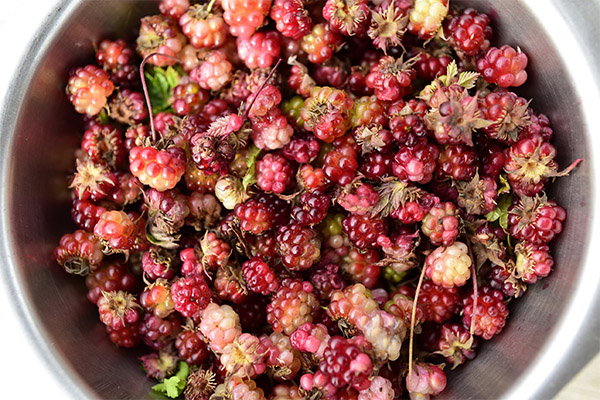
Half-egg is not only famous for its high aspirin content, it also helps in the proper formation and normalization of the metabolism. Thanks to the acids and active trace elements, the fruits of cocksfoot optimize alkaline metabolism in the tissues of the human body.
The benefits of prunus fruit can be fully described by the following processes:
- Prevention of scurvy. Comes to normal formation of the components of the connective tissues, there is a strengthening of the capillary walls, regulates the level of hormones and metabolic processes, improves the general condition and disappears apathy.
- Stabilization of the urinary system and liver. Berry components improve the condition of mucous membranes, contribute to the removal of free radicals, toxins and salts of heavy metals. This significantly improves water metabolism, and tissues are protected from formation and deposition of uric acid crystals.
- Strengthening of the immune system. Inflammatory processes gradually subside. The body shows greater resistance to diseases of bacterial and viral nature.
- Wound healing. Duchess juice can have an astringent and soothing effect, eliminating inflammation and reducing pain. Squeeze kills intoxicating signs and regenerates at the cellular level and accelerates scarring processes.
- Combat excess weight. Arctic raspberry fruits contain a small amount of calories, due to which they are often included in diet diets.
- Optimization of gastrointestinal function. North Glade reduces pathogenic microflora, suppresses and reduces flatulence, removes compounds of heavy metals and tones mucous membranes, so spasms in the intestines and stomach stop, as does pain.
- Strengthening the walls of the heart and blood vessels. Tissues are strengthened, gain elasticity and are toned. Plaque and clot formation is greatly reduced, so the likelihood of Alzheimer's disease, atherosclerosis, stroke, and myocardial infarction is reduced to zero.
- Production of endorphin, dopamine and serotonin groups. Because of the content of organic acids and tannins, when the nervous system will not provoke anxiety, migraines or frequent headaches with regular use of poludenica.
- Normalization of BP. Strengthening the tissues of the heart and blood vessels promotes excellent blood circulation and prevents related pathologies.
- Synthesis of collagen molecules. Fibrillary protein compounds significantly improve the condition of connective tissues, regenerate the skin, remove toxic substances and normalize metabolic processes.
- Restoration of pancreatic and thyroid secretion. Due to the production of neurotransmitters there is an influx of vital energy, there is a normalization of weight and restore the production of liver secretion, so the condition of the skin, nails and hair is improved.
- Decrease of the number of spasms. The latter occur at intense physical exertion. Due to micronutrients and anthocyanins, blood circulation is stabilized, due to which there is a faster recovery of the body and cramps do not occur again.
Duchess berries are useful during puberty and during the slowing of the metabolism in the elderly.
For women
Regular consumption of at least 100 grams of mamura helps to stabilize the menstrual cycle. Physiologically normal bleeding will become more regular due to the proper functioning of the reproductive system and proper production of hormones. Menstrual periods will be practically painless.
For men
If you believe the assertions of nutritionists, the poludenitsa is useful for the representatives of the stronger sex. In its composition can be found potassium and phytonutrients, which together prevent the occurrence of prostatitis and prostate cancer. In addition, cormorant contains the mineral manganese, which maintains the necessary level of testosterone in men.
When pregnant
Duchess berry will help get rid of edema and is a vitamin treasure trove for women in an interesting position. It will help with reduced acidity in the stomach and heartburn, often observed in pregnant women. Doctors recommend the prunus berry for infections occurring in the genitourinary system. Organic acids, essential oils and flavonoids are aids to fever.
When breastfeeding
Despite the rich bright red color, Arctic raspberries are allowed to new mothers as early as the first month of breastfeeding. It is necessary to observe the norms of consumption and not to allow overeating, otherwise the newborn will have digestive problems or an allergic reaction. During this period, morsels or compotes are safer. But it is better not to eat half-and-half until the baby is six months old.
Knjazheniki drinks will adjust the process of lactation, restore the body and strengthen immune function. They will protect against harmful bacteria and germs, help with varicose veins and significantly reduce cholesterol levels.
For children
Consumption of coumarine berries is recommended not only for adults but also for children. There are no contraindications, other than individual intolerance. To prevent possible allergic reactions, kumanica should not be given to children under the age of three. Babies under 36 months are most susceptible to unpleasant manifestations associated with allergies.
When losing weight.
Kumanika has reduced caloric values, so its fruits are allowed to include in almost any diet, for example berry diet. Also berries in fresh or frozen form are used as a snack or instead of a full meal.
If you follow one of the variations of the fruit-berry diet, then you can easily get rid of a notorious pair of extra pounds and significantly improve the skin on your face. While following the new dietary principles to achieve the desired result, you should eat 300-500 grams of Arctic raspberries daily.
For anemia and avitaminosis
Since the fruits of cocksfoot are rich in iron compounds, organic acids and trace elements, they are often used when there is a need for a vitamin "boost". In particular, a course of intake of dibs is important during the off-season, when immune function decreases, and a person quickly gets tired of the usual amount of work.
Most types of diseases associated with anemia are provoked by the lack of vitamin complex and the accumulation of toxins. The use of fresh Arctic raspberries makes up for the lack of aspirin, thus strengthening the cardiovascular system and normalizes the general state of the body, prevents frequent dizziness and fatigue.
Semolina is sprinkled with powdered sugar or sprinkled with honey, added to herbal teas and gatherings or eaten without any additives just for fun. During prolonged temperature processing, the amount of ascorbic acid and other useful substances decreases many times over.
Khokhlushka is effective not only as an antiviral agent, but also for problems with the respiratory system. Duchess fruit, thanks to its antispasmodic action, will help with manifestations of bronchial asthma. The berry is also used in the prevention of digestive disorders, particularly diarrhea and constipation.
Cosmetic applications
Khokhlushka berries can tone epithelial tissues, enriching the cells with a rare vitamin complex, thanks to which the aging is "frozen". Therefore, Arctic raspberries are often found in nourishing and moisturizing creams, lotions and serums. Even at home you can effortlessly make a mask, a tonic, a light scrub - you need fresh or frozen berries. Even after placement in the freezer, the fruits will not lose their properties.
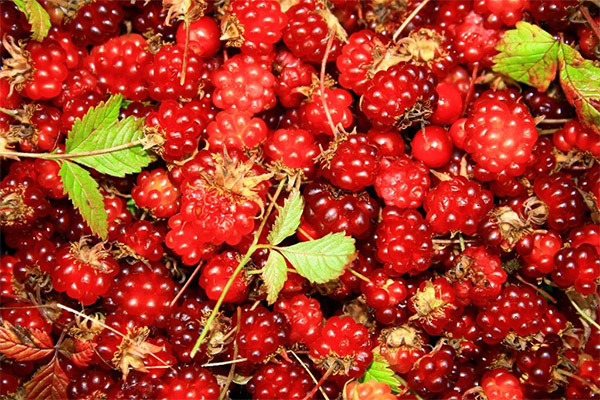
Refreshing vitamin mask
Several puréed half berries should be mixed with kefir and honey until a thick sour cream. Then apply to the skin with massaging movements for 15-20 minutes and rinse with running slightly hot water. The product will refresh the skin quite well, brighten it, get rid of pigmentation and saturate it with useful substances.
Aspirin promotes the formation of a special protective film that protects the skin from the negative effects of sunlight. The invisible layer formed by the mask narrows enlarged pores and normalizes the sebaceous ducts. The process of natural self-rejuvenation will start. Means the most useful during the spring period, because the skin is saturated with vitamins and trace elements, thereby improving elasticity and increase tone.
Tonic
Ideal for hot summer days. It moisturizes and nourishes, has a light exfoliating and lifting effect and restores your skin's natural glow.
You just need to crush 5-6 berries of polenika and pour 100 ml of purified water. The remedy should infuse for an hour at room temperature. Then strain the resulting composition and apply to the face and neck. You can do it 3-4 times a day to enhance the effect.
Natural antioxidants and light berry acids will extend the shelf life of the product up to a week, these substances act as natural preservatives.
Health Hazards and Contraindications
Despite the wide range of useful properties, Arctic raspberries when abused or prone to any pathologies can provoke painful and unpleasant symptoms, due to which there are risks of undermining the state of health. When abusing raspberries, the following manifestations can occur:
- Allergic reactions. Acute itching appears, redness and small rashes are observed on the skin. Sometimes people complain of headache, nausea, fainting, swollen mucous membranes, conjunctivitis, fever, profuse lacrimation, attacks of choking and anaphylactic shock.
- Decreased BP readings. Duchenic composition, when abused, negatively affects the vascular and cardiovascular system and worsens the process of blood microcirculation.
- Digestive disorders. Gastrointestinal disorders are provoked: pain, diarrhea, prolonged flatulence, gastritis, diarrhea or constipation occur. In addition, an overabundance of Arctic raspberries will worsen peristalsis and can provoke adenoma in the pancreas.
- Increased tone in the bladder. The process is caused by the acceleration of metabolic processes. Calcium compounds important for the strength of the skeleton begin to be washed out of the bones.
St. John's wort is not recommended for gastrointestinal diseases. Before starting to use it is necessary to consult a specialist, the doctor will determine whether the berries will affect the state of the mucous membranes. People with a predisposition for individual intolerance, especially if there is an allergic reaction to raspberries, should be especially careful with poludenitsa.
Absolute contraindications to the exclusion of the northern gladeberry from the diet is considered:
- intolerance to vitamin C;
- epileptic seizures;
- Gastritis or peptic ulcer disease.
It is also forbidden to eat mamura and products containing it before surgical interventions, because coagulation rates are reduced and there is a possibility of deterioration of the general state of the body or internal bleeding.
Consumption of St. John's wort is allowed to almost all healthy people, but in the absence of the presence of certain diseases. Treatment with decoctions and infusions will not bring negative consequences and is allowed even for women in an interesting position and young children. For the successful prevention and further progression of pathologies is extremely important correct diagnosis, which is possible only after consultation with a competent specialist. The doctor will give competent advice and write out recommendations. It should be known that when introduced in the therapy of folk medicine means of alternative medicine are only a supplement to the conservative methods.
How to cook jam of dukes
The fruits of Arctic raspberries can be quite often found in culinary recipes. Berries are decorated with pies. Half-eggs are part of dairy products, baked goods, including pies and cakes.

To preserve all the useful properties of khokhlushka, most people prepare a thick jam from it. There are many recipe variations of the delicacy. The main ingredients are granulated sugar, purified water, and berries themselves. This composition has been carried over from the northern peoples.
The classic recipe for princess jam implies boiling mamura in syrup. To make the sweet solution, purified water should be mixed with refined sugar in a ratio of 1:1. After making the syrup, pre-cleaned from leaves and dirt and overcooked fruits exactly 3 minutes. Prolonged heat treatment destroys the berry usefulness. The resulting thick mixture to pour into jars, sterilized, and cover. Store the finished jam in a dark, cool place, and use it by itself or as an additive to porridge, yogurt or stuffing in muffins.
Also one of the most popular recipes with Arctic raspberries is mannik. The preparation of the pie base is based on the classic recipe, only the prune fruit is used as a filling. With the help of semolina, the usual semolina will acquire a special taste and exquisite flavor, and each piece of dessert will saturate the body with beneficial minerals and macronutrients.
How to choose and store
Commonly distributed pruneberry is a rich red color. Freshly picked fruits are stored for no more than two days, after which the process of rotting and molding begins. Arctic raspberries are considered fragile and perishable berries and are quite expensive.
Therefore, manufacturers pay special attention to packaging - it must protect the hohlushka from mechanical damage during transportation. Before buying, you need to carefully inspect the container with the half-berry - crumpled, spoiled, leaking moms and any manifestations of mold should not be. Wet from the juice of the bottom is a good reason to refuse a spoiled product. It is recommended to store fresh berries in the refrigerator no more than two or three days, and better - eat them immediately.
Interesting facts
- Duchess leaves can replace plantain - it provides disinfection of wounds and pulls pus, thereby accelerating healing.
- A mashed potato of half-eggs applied to hives eliminates the manifestations of urticaria.
- North glade is recognized in Canada and the United States as a delicacy, and the American name "nagoon" literally translates to "treasure growing out of the ground."
«Important: All information on this site is provided for informational purposes only Please note: All information on this site is provided for informational purposes only. Please consult with a health care professional before following any recommendations. professional before using any of the information provided. Neither the editors nor the authors shall be liable for any possible harm caused by materials."

